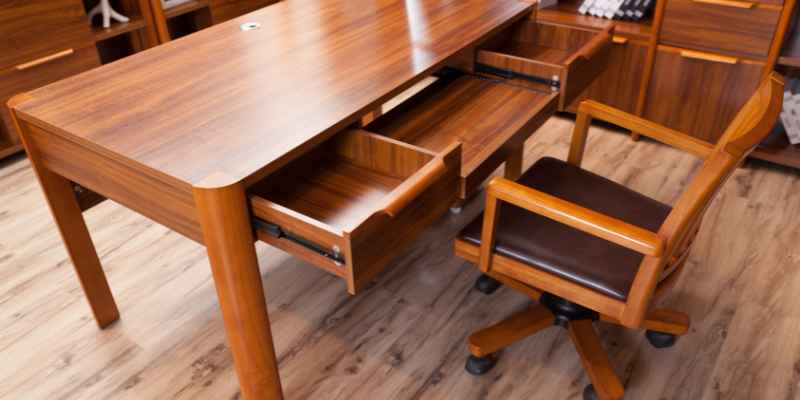Wood oil furniture refers to furniture treated with natural oils to enhance appearance and durability. This finish protects wood while highlighting its natural grain.
Wood oil finishes have gained popularity for their aesthetic and protective qualities. They penetrate deep into the wood, offering moisture resistance and enhancing the natural beauty of the grain. Unlike varnishes or paints, wood oils maintain a more natural look, allowing the character of the wood to shine through.
Regular application can prolong the life of your furniture, making it a practical choice for both indoor and outdoor pieces. Many types of oils, such as tung oil and linseed oil, are available, each providing unique benefits. Choose wood oil furniture for a blend of elegance and lasting protection.
Introduction To Wood Oil
Wood oil is essential for maintaining furniture. It protects wood and enhances its beauty. Many types of wood oils exist, each offering unique benefits. Using wood oil keeps your furniture looking new and vibrant.
Benefits Of Using Wood Oil
Wood oil provides several benefits for your furniture. Here are some key advantages:
- Protection: It guards against moisture and spills.
- Enhancement: It brings out the natural grain of the wood.
- Durability: It increases the lifespan of your furniture.
- Easy Application: Applying wood oil is simple and quick.
- Non-Toxic: Many wood oils are safe for indoor use.
Types Of Wood Oil
Different types of wood oil suit various needs. Here’s a table showing popular options:
| Type of Wood Oil | Best For | Key Features |
|---|---|---|
| Tung Oil | Indoor furniture | Water-resistant, durable finish |
| Linseed Oil | Woodworking projects | Natural, enhances grain |
| Teak Oil | Outdoor furniture | UV protection, weather-resistant |
| Walnut Oil | Food-safe items | Non-toxic, enhances color |
Choose the right wood oil for your needs. Each type offers special benefits. Proper selection helps maintain your furniture’s beauty.

Preparing Your Furniture For Oiling
Oiling your wood furniture enhances its beauty and longevity. Proper preparation is vital for the best results. Follow these steps to ensure your furniture is ready for oil application.
Cleaning The Surface
Start by cleaning your furniture thoroughly. A clean surface helps the oil absorb better. Use a soft cloth and a gentle cleaner. Avoid harsh chemicals that can damage the wood.
- Dust the surface with a microfiber cloth.
- Mix mild soap with warm water.
- Dampen a cloth with the solution and wipe the furniture.
- Rinse with a clean, damp cloth.
- Dry the surface completely with a towel.
Sanding For Smoothness
Sanding prepares the wood for oil. It removes old finishes and smooths rough areas. Use fine-grit sandpaper for the best finish.
- Begin with 120-grit sandpaper.
- Sand in the direction of the wood grain.
- Check for smoothness after each pass.
- Switch to 220-grit sandpaper for a finer finish.
- Wipe away dust with a damp cloth.
Sanding ensures the oil penetrates well. This step is crucial for a beautiful finish.
Choosing The Right Oil For Your Furniture
Choosing the right oil for your furniture is crucial. It enhances beauty and protects wood. Different oils offer various benefits. Understanding these helps in making a wise choice.
Linseed Oil: Pros And Cons
Linseed oil is a popular choice for wood furniture. It comes from flax seeds and is easy to find.
- Pros:
- Natural and safe for the environment
- Enhances wood grain
- Affordable option
- Cons:
- Takes a long time to dry
- Can become sticky
- May yellow over time
Teak Oil And Its Uses
Teak oil is specially designed for teak wood. It protects against moisture and UV rays. This oil is ideal for outdoor furniture.
It penetrates deep into the wood, preventing cracking. Regular application keeps the wood looking fresh.
| Feature | Description |
|---|---|
| Water Resistance | High |
| UV Protection | Excellent |
| Application Frequency | Every 6-12 months |
Tung Oil: A Durable Choice
Tung oil is a durable option for wood furniture. It comes from the nuts of the tung tree. This oil creates a hard, water-resistant finish.
It dries quickly and enhances the wood’s natural beauty. Tung oil is ideal for high-use items.
- Ideal for tabletops and kitchen items.
- Offers long-lasting protection.
- Requires fewer applications compared to other oils.
Choose the right oil based on your furniture needs. Each option has unique benefits.
Step-by-step Guide To Applying Wood Oil
Applying wood oil can enhance the beauty of your furniture. This guide provides clear steps to achieve a professional finish. Follow these simple instructions to protect and nourish your wooden pieces.
Applying The First Coat
Start with a clean surface. Remove dust and dirt with a soft cloth. Ensure the wood is completely dry. Choose a high-quality wood oil for best results.
- Use a clean cloth or brush.
- Dip it into the wood oil.
- Apply a thin, even coat.
- Work in the direction of the grain.
- Cover all areas, including edges.
Let the first coat dry. Drying time varies by product. Check the manufacturer’s instructions.
Sanding Between Coats
Sanding improves adhesion. It creates a smoother finish. Follow these steps for sanding:
- Use fine-grit sandpaper (220-grit is ideal).
- Lightly sand the surface after the first coat dries.
- Focus on areas with uneven spots.
- Remove dust with a damp cloth.
Allow the surface to dry before applying the next coat. Sanding helps achieve a polished look.
Final Coat Application
After sanding, apply the final coat of wood oil. This coat adds depth and protection. Follow these steps:
- Use the same technique as before.
- Apply a slightly thicker coat.
- Ensure even coverage across the surface.
- Let it dry completely.
After drying, assess the finish. If needed, apply a third coat for extra durability. Enjoy your beautifully finished wood furniture.
Maintaining Oiled Furniture
Maintaining oiled furniture keeps it looking beautiful and durable. Proper care enhances the natural grain and color. Regular upkeep prevents damage and extends the life of your furniture.
Regular Cleaning Tips
Cleaning oiled furniture is simple. Follow these tips for best results:
- Dust Regularly: Use a soft cloth to remove dust.
- Use Mild Soap: Mix soap with water for a gentle cleaner.
- Wipe Spills: Clean up spills immediately to avoid staining.
- Avoid Harsh Chemicals: Do not use bleach or strong cleaners.
Follow this cleaning schedule:
| Frequency | Action |
|---|---|
| Weekly | Dust surfaces. |
| Monthly | Deep clean with mild soap. |
| As Needed | Wipe spills and stains. |
Re-oiling: When And How
Re-oiling is essential for maintaining your furniture’s finish. It protects the wood and enhances its beauty. Follow these guidelines for re-oiling:
- Check Regularly: Inspect the surface every few months.
- Look for Signs: If the wood appears dry or dull, it needs re-oiling.
- Select the Right Oil: Use a high-quality wood oil.
- Apply Oil: Use a clean cloth. Apply a thin layer evenly.
- Let it Soak: Allow the oil to absorb for 20-30 minutes.
- Buff the Surface: Wipe off excess oil with a dry cloth.
Re-oil your furniture every 6-12 months. Adjust the frequency based on wear and tear.
Troubleshooting Common Issues
Wood oil furniture enhances beauty and durability. Sometimes, issues arise. Here are solutions to common problems.
Dealing With Stains
Stains can appear on wood oil furniture. They may be from spills, dirt, or grease. Here are some steps to remove them:
- Act quickly: Wipe spills immediately with a clean cloth.
- Use mild soap: Mix soap with water and gently scrub.
- Try vinegar: Mix equal parts vinegar and water. Apply gently.
- Test first: Always test cleaners on a small area first.
Fixing Uneven Coats
Sometimes, the wood oil finish looks uneven. This can happen due to improper application. Follow these steps to fix it:
- Sand lightly: Use fine-grit sandpaper to smooth the area.
- Clean the surface: Remove dust with a damp cloth.
- Apply oil: Use a clean cloth to apply a thin coat.
- Allow drying: Let the oil dry completely before use.
Addressing Stickiness
Sticky surfaces can frustrate anyone. This issue often arises from excess oil. Here’s how to fix it:
- Wipe down: Use a soft cloth to remove excess oil.
- Use mineral spirits: Apply a small amount to a cloth.
- Rinse and dry: Wipe with a damp cloth and dry thoroughly.
- Reapply oil: Only apply a light coat after drying.
Eco-friendly And Safe Oiling Practices
Wood oil furniture requires careful attention to eco-friendly practices. Using safe oils helps protect your health and the environment. Choosing the right oils is crucial for maintaining your furniture and safety.
Choosing Non-toxic Oils
Selecting non-toxic oils is vital for a safe home. Many oils are available that do not release harmful chemicals. Here are some popular options:
- Linseed Oil: A natural choice from flax seeds.
- Tung Oil: Derived from the seeds of the tung tree.
- Walnut Oil: A food-safe option for furniture.
- Coconut Oil: Great for conditioning and polishing.
These oils provide durability and enhance the wood’s natural beauty. Always read labels to ensure products are eco-friendly.
Safe Disposal Of Rags
After using oils, disposal of rags is important. Oily rags can catch fire if not handled correctly. Follow these steps for safe disposal:
- Soak rags in water immediately after use.
- Place rags in a metal container with a lid.
- Dispose of the container according to local regulations.
Never leave oily rags in a pile. This can lead to spontaneous combustion. Keep your home safe by following these guidelines.
Showcasing Your Revitalized Furniture
Revitalizing furniture with wood oil brings new life and beauty. Your pieces will shine and make a statement in any room. Properly showcasing them enhances their appeal. Here are some tips to help you style and protect your revitalized furniture.
Styling Tips
Styling your wood oil furniture can transform your space. Use these tips to create a stunning display:
- Choose a Focal Point: Select a standout piece to draw attention.
- Mix Textures: Combine wood with fabrics or metals for contrast.
- Use Natural Light: Place furniture near windows for a fresh look.
- Add Accessories: Use vases, books, or art to enhance decor.
- Keep It Simple: Avoid clutter. Less is often more.
Protecting From Sunlight And Humidity
Sunlight and humidity can damage your furniture. Protect your pieces to keep them looking great:
- Use Window Treatments: Curtains or blinds reduce direct sunlight.
- Humidity Control: Keep a dehumidifier in damp areas.
- Regular Maintenance: Reapply wood oil every few months.
- Use Coasters: Protect surfaces from moisture and heat.
These steps will help maintain the beauty and integrity of your revitalized furniture.

Frequently Asked Questions
What Is Wood Oil Furniture?
Wood oil furniture refers to items treated with natural oils. These oils enhance the wood’s appearance and protect it from damage. Common oils include linseed and tung oil. This treatment helps maintain the wood’s natural beauty while providing a durable finish that resists wear and tear.
How Do I Apply Wood Oil To Furniture?
To apply wood oil, start by cleaning the surface. Use a soft cloth and ensure the wood is dry. Apply a thin layer of oil with a brush or cloth, working in the direction of the grain. Allow it to absorb for a few minutes, then wipe off excess oil.
How Often Should I Oil My Furniture?
The frequency of oiling depends on usage and environment. Generally, reapply wood oil every 6 to 12 months. High-traffic items may require more frequent treatments. Regular maintenance helps preserve the finish and enhances the wood’s natural beauty for years to come.
Can I Use Any Oil For Wood Furniture?
Not all oils are suitable for wood furniture. Common options include linseed, tung, and mineral oil. Avoid using cooking oils, as they can go rancid. Always choose oils specifically designed for wood to ensure protection and enhance the finish effectively.
Conclusion
Choosing wood oil for your furniture enhances its natural beauty and durability. It protects against wear while maintaining a rich finish. Regular application keeps your pieces looking fresh and vibrant. Embrace wood oil as a simple solution for furniture care.
Invest in your wood furniture today for lasting enjoyment and style.

